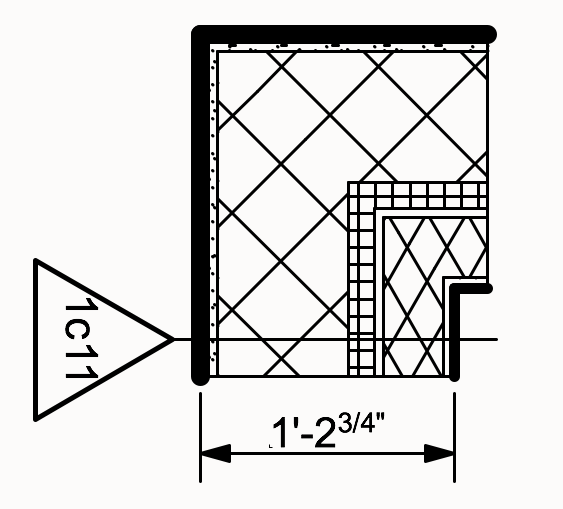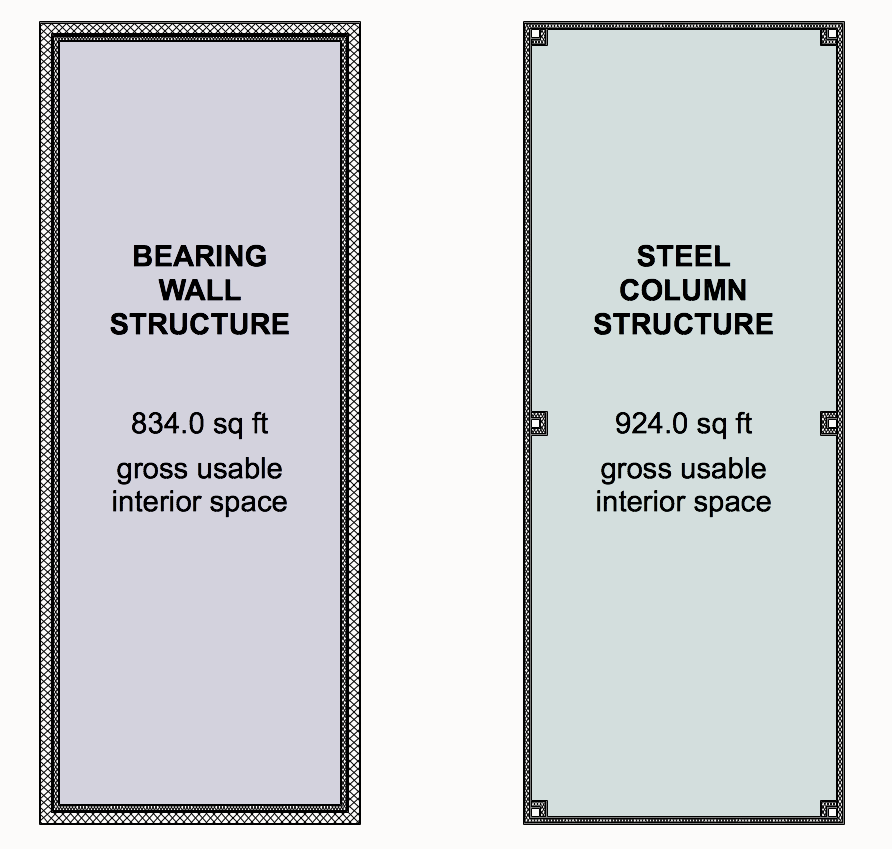FAR, the floor area ratio, is determined by multiplying the area of a property by a number determined by the property’s zoning district. For instance a 20’x100′ property in a zoning district of R5 has a factor of 1.25 allowing for 2500 square feet of ‘habitable’ interior space.
The issue is what is considered habitable. FAR accounts for the gross built area including thicknesses of walls, suggesting that the very walls that help define the interior spaces are habitable. This results in something unfortunate, the attempt to make structural walls thinner resulting in larger interior spaces, which results in buildings that feel less sturdy by the increase in noise infiltration, vibration and other factors.
Conventional building methods would provide for a bearing wall and insulation. This could easily result in a bearing wall that is 12 inches or more in thickness, especially considering the Energy Conservation Code requires an insulation rating of R-20. R-20 using batt insulation would result in a stud wall of having up to 7 inches extra beyond the thickness of the structural bearing wall. So Architects and Engineers devise ways to reduce this thickness in order to increase the actual habitable spaces within, or the net areas that people use to live in. One way is to use expandable foam insulation to reduce the thickness of the insulation portion of the wall. Another is to install exterior insulation that can be continuous but has it’s own issues like being a weak damage prone finish. The other ways have to do with the structure itself, like using a steel column system and abandoning the bearing wall system, bearing walls having the advantages of easy low-skill installation which distributes it’s load over spread out footings versus high-skill labor force to install steel and it’s resulting point loads on larger footings.

Ultimately the goal of the developer is to provide spacious interiors. The goal of the resident is to have spacious interiors in a dwelling that feels secure and private (free of noise transmission).
The issue is, FAR should be defining the net area of actual habitable space and not the gross area, and thus not affect the structural system approach. This slight change would result in better building stock that would be easier and more cost effective to construct. The factor used could be adjusted slightly to compensate for the extra area achieved but wouldn’t impede the engineering of the structural system and resulting quality of the structure.
While the plan illustrations clearly show the square footage advantage of a ‘Steel Column Structure’ and its impact on overall square footage, it’s the bearing wall structure that actually produces a better ‘high quality’ building at a lower cost. This makes one wonder if zoning is biased towards one structural system over another? The difference between the two system is about 90 square feet or essentially getting an extra interior room.
It is unfortunate that FAR (Floor Area Ratio) does not reflect the area on a property that can actually be inhabited and includes the area used for structure. It would be better if the area for structure can be removed from FAR calculations so that the public has more options for structural systems that do not punish those who choose one approach and reward those who choose another. For it is in the interest of the city to help developers leverage their finances for the betterment of all buildings, and as a result for the benefit of those who inhabit these buildings.
~Nic Buccalo, Architect; Principal of SimpleTwig Architecture.llc, c 2019


In 2012, New York City’s Zone Green program amended the Zoning Code to allow wall thickness to be deducted from floor area provided the walls are energy efficient. … This floor area deduction gives both older and newer buildings an opportunity to insulate their walls and save on energy costs.
This encourages a certain type of new construction, metal frame which isn’t as durable as reinforced concrete/block that does a better job in fire spread, damage due to winds or other forces, and in my opinion sound mitigation. For me, masonry creates a feeling of security and privacy. Of course there are disadvantages with masonry such as weight, cost and installation/labor compared to a framed structure. Unless the masonry is calculated as being a mass wall there isn’t any real energy calculation incentive to use it and in fact the system is being punished. Still, as you point out renovations can take advantage of the incentive to make them energy efficient.